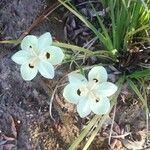Perennial herb, 0.7-1.0 m high; stem erect. Leaves pale green, linear, distichous; central vein usually double. Spathe herbaceous, apex obtuse or emarginate, margins free to base. Bracts folded, amplexicaul, margins scarious. Inflorescence ± as long as leaves; perianth saucer-shaped, yellow; outer segments broadly obovate, sometimes with dark brown nectar guides or with dotted tepal claws; outer tepals speckled orange, bearded. Stamens inserted, appressed against petaloid style crest; filaments 6 mm long; anthers 4-8 mm long. Ovary ± 10 mm long; style 2 mm long. Flowering time Aug.-May. Capsule up to 25 mm long, globose-truncate, dehiscent only in upper half.
A herb that has a bulb. It keeps growing from year to year. It grows 80 cm high and spreads 1 m wide. The leaves are narrow and sword shaped. The flowers are like iris flowers and pale yellow with brown blotches. The fruit is a club shaped capsule.

